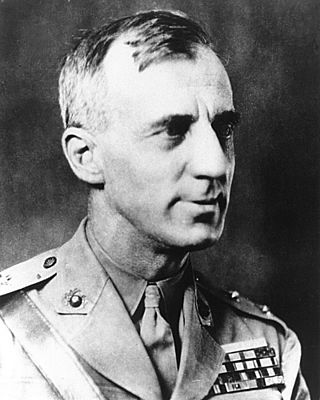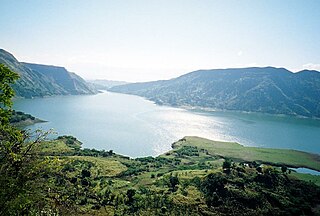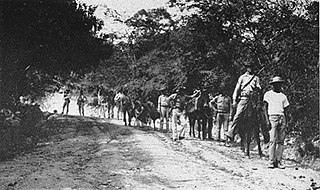
The recorded history of the Dominican Republic began in 1492 when Christopher Columbus, working for the Crown of Castile, arrived at a large island in the western Atlantic Ocean, later known as the Caribbean. The native Taíno people, an Arawakan people, had inhabited the island during the pre-Columbian era, dividing it into five chiefdoms. They referred to the eastern part of the island as Quisqueya, meaning 'mother of all lands.' Columbus claimed the island for Castile, naming it La Isla Española, which was later Latinized to Hispaniola.

Lewis Burwell "Chesty" Puller was a United States Marine Corps officer. Beginning his career fighting guerillas in Haiti and Nicaragua as part of the Banana Wars, he later served with distinction in World War II and the Korean War as a senior officer. By the time of his retirement in 1955, he had reached the rank of lieutenant general.

Major-General Smedley Darlington Butler was a United States Marine Corps officer and writer. During his 34-year military career, he fought in the Philippine–American War, the Boxer Rebellion, the Mexican Revolution, World War I, and the Banana Wars. At the time of his death, Butler was the most decorated Marine in U.S. military history. By the end of his career, Butler had received sixteen medals, including five for heroism; he is the only Marine to be awarded the Marine Corps Brevet Medal as well as two Medals of Honor, all for separate actions.

Centre or Sant is a central department of Haiti, located in the center of the country along the border with the Dominican Republic. As of 2015, its estimated population was 746,236. Its capital is Hinche.

The United States occupation of Haiti began on July 28, 1915, when 330 U.S. Marines landed at Port-au-Prince, Haiti, after the National City Bank of New York convinced the President of the United States, Woodrow Wilson, to take control of Haiti's political and financial interests. The July 1915 occupation took place following years of socioeconomic instability within Haiti that culminated with the lynching of President of Haiti Vilbrun Guillaume Sam by a mob angered by his decision to order the executions of political prisoners.

Daniel Joseph Daly was a United States Marine and one of nineteen U.S. servicemen to have been awarded the Medal of Honor twice. Daly and Major General Smedley Butler are the only Marines who earned two Medals of Honor for two separate acts of valor.
Fort Rivière is a ruined mountain fort in Haiti on the summit of Montagne Noire, Saint-Raphaël Arrondissement. It is on the north coast of Haiti to the south of Grande-Rivière-du-Nord and 20 miles south of Cap-Haïtien. It was a French bastion fort that was the site of the defeat of the Haitian rebel force called the Cacos on 17 November 1915.

The United States occupation of Nicaragua from August 4, 1912, to January 2, 1933, was part of the Banana Wars, when the U.S. military invaded various Latin American countries from 1898 to 1934. The formal occupation began on August 4, 1912, even though there were various other assaults by the United States in Nicaragua throughout this period. American military interventions in Nicaragua were designed to stop any nation other than the United States of America from building a Nicaraguan Canal.

Charlemagne Masséna Péralte was a Haitian nationalist leader who opposed the United States occupation of Haiti in 1915. Leading guerrilla fighters called the Cacos, he posed such a challenge to the US forces in Haiti that the occupying forces had to upgrade their presence in the country; he was eventually killed by American troops. Where he was symbolically crucified, Péralte remains a highly praised hero in Haiti.

The Military Government of Santo Domingo was a provisional military government established during the American occupation of the Dominican Republic that lasted from May 13, 1916 to September 18, 1924. The United States aimed to force the Dominicans to repay their large debts to European creditors, whose governments threatened military intervention. On May 13, 1916, Rear Admiral William B. Caperton forced the Dominican Republic's Secretary of War Desiderio Arias, who had seized power from President Juan Isidro Jimenes Pereyra, to leave Santo Domingo by threatening the city with naval bombardment.

Major General William Peterkin Upshur was a United States Marine Corps officer and the recipient of the Medal of Honor, the United States' highest military decoration, for his actions in 1915 during the Haitian Campaign.

Herman Henry Hanneken was a United States Marine Corps officer and a recipient of the U.S. military's highest decoration, the Medal of Honor.

The Battle of Fort Dipitié was fought on 24–25 October 1915 as part of the First Caco War during United States occupation of Haiti. U.S. Marines and rebel Haitians, known as Cacos, fought at the Grande Rivière du Nord which resulted in the destruction of Fort Dipitié, an outpost of Fort Capois.

The Battle of Fort Rivière was the decisive battle of the First Caco War during United States occupation of Haiti in 1915. A combined force of U.S. Marines and sailors defeated Cacos rebels at Fort Rivière, ending the First Caco War.
The Nicaraguan Civil War of 1926–1927, or the Constitutionalist War, broke out after a coup d'état by Emiliano Chamorro, a member of the Conservative Party, removed Nicaragua's democratically elected government, resulting in a rebellion by members of the Liberal Party. The conflict came to an end after a military and diplomatic intervention by the United States resulted in the Pact of Espino Negro, which began the Peace of Tipitapa. Although the civil war came to an end, one Liberal general, Augusto César Sandino, refused to lay down his arms and waged the Sandino Rebellion against the Nicaraguan government and the US Marine Corps until 1933.

The Gendarmerie of Haiti, also known as the Haitian Constabulary, was a Haitian gendarmerie raised during the United States occupation of Haiti. Established in 1915 under U.S. military guidance, the gendarmerie was operational from 1916 until 1928, during which time it was Haiti's only military force, earning a reputation for active interference in civilian government that may have set the stage for the future politicization of the Armed Forces of Haiti. From 1918 to 1920, the gendarmerie fought in the Second Caco War. It was reorganized as the Haitian Guard in 1928, forming the nucleus of what would evolve into the modern military of Haiti.
The Battle of Port-au-Prince, or "la débâcle", took place on January 15, 1920 when Haitian rebels, known as Cacos, attacked the capital of Haiti during the Second Caco War and the American occupation of Haiti.
In Haitian history, Cacos were bodies of armed men, originally drawn from the country's enslaved population, who came to wield power in the mountainous regions of Haiti following the victory of the Haitian Revolution in 1804. The nickname "cacos" was derived from local terms for the red-plumed Hispaniolan trogon because the insurgents "used to hide, like the bird of the same name, under the leaves so as to come unexpectedly upon and attack their enemy."
The Les Cayes massacre, also known as the Marchaterre massacre, was a massacre on 6 December 1929 in Les Cayes perpetrated by United States Marine Corps (USMC) troops against Haitians protesting the United States occupation of Haiti. The massacre was instrumental in placing pressure on the United States to withdraw its occupying forces from Haiti.
Benoît Batraville, nicknamed "Ti-Benwa", was a Haitian teacher and resistance fighter against the American occupation, executed by the US Marines.













